CDE Technology – Dimmable led lamp Cold White
Posted by Marcel van der Steen in Led lights, Light measurements Add comments presents a led lamp with a pear shape. It emits light all around and it has a cold white color temperature. The lamp is dimmable.
presents a led lamp with a pear shape. It emits light all around and it has a cold white color temperature. The lamp is dimmable.
This article shows the measurement results. Many parameters are also found in the Eulumdat file.
See this overview for a comparison with other light bulbs.

Summary measurement data
| parameter | meas. result | remark |
|---|---|---|
| Color temperature | 5912 K | Cold white |
| Luminous intensity Iv | 56 Cd | Measured straight underneath the lamp. |
| Illuminance modulation index | 2 % | Measured straight underneath the lamp. Is a measure for the amount of flickering. |
| Beam angle | 193 deg | 193º for all C-planes since the lamp is symmetrical along its 1st axis. |
| Power P | 7.6 W | |
| Power Factor | 0.57 | For every 1 kWh net power consumed, there has been 1.4 kVAhr for reactive power. |
| THD | 129 % | Total Harmonic Distortion |
| Luminous flux | 390 Lm | |
| Luminous efficacy | 51 Lm/W | |
| CRI_Ra | 74 | Color Rendering Index. |
| Coordinates chromaticity diagram | x=0.3234 and y=0.3410 | |
| Fitting | E27 | This lamp is connected to the 230 V grid voltage. |
| PAR-value | 0.5 μMol/s/m2 | The number of photons seen by an average plant when it is lit by the light of this light bulb. Value valid at 1 m distance from light bulb. |
| PAR-photon efficacy | 0.5 μMol/s/We | The toal emitted number of photons by this light, divided by its consumption in W. It indicates a kind of efficacy in generating photons. |
| S/P ratio | 2.0 | This factor indicates the amount of times more efficient the light of this light bulb is perceived under scotopic circumstances (low environmental light level). |
| D x H external dimensions | 59 x 116 mm | External dimensions of the lamp. |
| D x H luminous area | 59 x 35 mm | Dimensions of the luminous area (used in Eulumdat file). This is the surface of the matte bulb. |
| General remarks | The ambient temperature during the whole set of measurements was 25-25.5 deg C. The temperature of the housing with coolribs gets about 50 degrees hotter than ambient temperature. Warm up effect: during the warm up time the illuminance decreases with 10 % and the consumed power with less than 5 %. Voltage dependency: the power consumption and illuminance vary little, and in a linear way, when the power voltage varies between 200-250 V. This lamp is tested on dim-ability and is found to be well dimmable. |
|
| Measurement report (PDF) | ||
| Eulumdat file |  |
Right click on icon and save the file. |
Overview table
The overview table is explained on the OliNo website.
Please note that this overview table makes use of calculations, use this data with care as explained on the OliNo site. E (lux) values are not accurate, when within 5 x 59 mm ≈ 300 mm. Within this distance from the lamp, the measured lux values willl be less than the computed values in this overview as the measurements are then within the near field of the lamp.
Note II: the beamangle > 180 degrees and hence the half peak diameters and the Ø50% spot size are not defined. Discard the negative values.
Eulumdat light diagram
This light diagram below comes from the program Qlumedit, that extracts these diagrams from an Eulumdat file. It is explained on the OliNo site.
The light diagram giving the radiation pattern.
It indicates the luminous intensity around the light bulb. All the planes give the same results as the lamp is symmetrical along its 1st axis.
Illuminance Ev at 1 m distance, or luminous intensity Iv
Herewith the plot of the averaged luminous intensity Iv as a function of the inclination angle with the light bulb.
The radiation pattern of the light bulb.
This radiation pattern is the average of the light output of the light diagram given earlier. Also, in this graph the luminous intensity is given in Cd.
These averaged values are used (later) to compute the lumen output.
Intensity data of every measured turn angle at each inclination angle.
This plot shows per inclination angle the intensity measurement results for each turn angle at that inclination angle. There normally are differences in illuminance values for different turn angles. However for further calculations the averaged values will be used.
When using the average values per inclination angle, the beam angle can be computed, being 193º for all C-planes looked at.
Luminous flux
With the averaged illuminance data at 1 m distance, taken from the graph showing the averaged radiation pattern, it is possible to compute the luminous flux.
The result of this computation for this light spot is a luminous flux of 390 Lm.
Luminous efficacy
The luminous flux being 390 Lm, and the power of the light bulb being 7.6 W, yields a luminous efficacy of 51 Lm/W.
Electrical properties
A power factor of 0.57 means that for every 1 kWh net power consumed, a reactive component of 1.4 kVAr was needed.
| Lamp voltage | 230 VAC |
| Lamp current | 58 mA |
| Power P | 7.6 W |
| Apparent power S | 13.4 VA |
| Power factor | 0.57 |
Of this light bulb the voltage across ad the resulting current through it are measured and graphed. See the OliNo site how this is obtained.
Voltage across and current through the lightbulb
This waveforms have been checked on requirements posed by the norm IEC 61000-3-2:2006 (including up to A2:2009). See also the explanation on the OliNo website.
Harmonics in in the current waveform and checked against IEC61000-3-2:2006
There are no limits for the harmonics for lighting equipment <= 25 W.
The Total Harmonic Distortion of the current is computed as 129 %.
Temperature measurements lamp
Determination of the correct emissivity. It seems to be equal to that of the tape.
The used tape has an emissivity of about 0.95.
The maximum temperature is found between the ribs.
| status lamp | > 2 hours on |
| ambient temperature | 26 deg C |
| reflected background temperature | 26 deg C |
| camera | Flir T335 |
| emissivity | 0.95(1) |
| measurement distance | 0.2 m |
| IFOVgeometric | 0.3 mm |
| NETD (thermal sensitivity) | 50 mK |
(1) The emissivity is set equal to the masking tape that is being used.
Color temperature and Spectral power distribution
The spectral power distribution of this light bulb, energies on y-axis valid at 1 m distance.
The measured color temperature is about 5900 K which is cold white.
This color temperature is measured straight underneath the light bulb. Below a graph showing the color temperature for different inclination angles.
Color temperature as a function of inclination angle.
The measurement of CCT is measured for inclination angles up to 90º.
The beam angle is 193º, meaning a 96.5º inclination angle. In this area most of the light is present. The variation in correlated color temperature in the area up to 90 degrees inclination angle is about 3 %.
PAR value and PAR spectrum
To make a statement how well the light of this light bulb is for growing plants, the PAR-area needs to be determined. See the OliNo website how this all is determined and the explanation of the graph.
The photon spectrum, then the sensitivity curve and as result the final PAR spectrum of the light of this light bulb
| parameter | value | unit |
|---|---|---|
| PAR-number | 0.5 | μMol/s/m² |
| PAR-photon current | 3.5 | μMol/s |
| PAR-photon efficacy | 0.5 | μMol/s/W |
The PAR efficiency is 65 % (valid for the PAR wave length range of 400 – 700 nm). So maximally 65 % of the total of photons in the light is effectively used by the average plant (since the plant might not take 100 % of the photons at the frequency where its relative sensitivity is 100 %).
S/P ratio
The S/P ratio and measurement is explained on the OliNo website. Here the results are given.
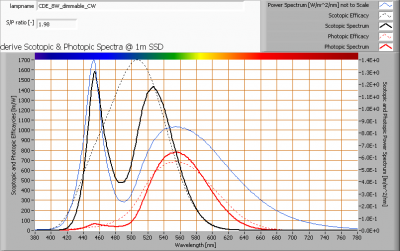
The power spectrum, sensitivity curves and resulting scotopic and photopic spectra (spectra energy content defined at 1 m distance).
The S/P ratio is 2.0.
More info on S/P ratio can be found on the OliNo website.
Chromaticity diagram
The chromaticity space and the position of the lamp’s color coordinates in it.
The light coming from this lamp is inside the area designated with class A. This class A is an area that is defined for signal lamps, see also the OliNo website.
Its coordinates are x=0.3234 and y=0.3410.
Color Rendering Index (CRI) or also Ra
Herewith the image showing the CRI as well as how well different colors are represented (rendered). The higher the number, the better the resemblance with the color when a black body radiator would have been used (the sun, or an incandescent lamp). Practical information and also some critics about the CRI can be found on the OliNo website.
Each color has an index Rx, and the first 8 indexes (R1 .. R8) are averaged to compute the Ra which is equivalent to the CRI.
CRI of the light of this lightbulb.
The value of 74 is lower than 80 which is considered a minimum value for indoor usage.
Note: the chromaticity difference is 0.0010 indicates the distance to the Planckian Locus. There is no norm yet that states what the max deviation from white light is allowed to be. A reference with signal lights as a reference is given in the chromaticity diagram.
Voltage dependency
The dependency of a number of lamp parameters on the lamp voltage is determined. For this, the lamp voltage has been varied and its effect on the following light bulb parameters measured: illuminance E_v [lx], the lamppower P [W] and the luminous efficacy [Lm/W].
Lamp voltage dependencies of certain light bulb parameters, where the value at 230 V is taken as 100 %.
The illuminance and consumed power vary slightly when the voltage is varied.
When the voltage at 230 V varies with + and – 5 V, then the illuminance varies < 1 %, so when abrupt voltage changes occur this effect is not visible in the illuminance output.
Warm up effects
After switch on of a cold lamp, the effect of heating up of the lamp is measured on illuminance E_v [lx], the lamppower P [W] and the luminous efficacy [lm/W].
Effect of warming up on different light bulb parameters. At top the 100 % level is put at begin, and at bottom at the end.
The warm up time is about 30 minutes during which the illuminance decreases with 10 %.
Measure of flickering
An analysis is done on the measure of flickering of the light output by this light bulb. See the OliNo site for more information.
The measure of fast illuminance variartion of the light of the light bulb
| parameter | waarde | eenheid |
|---|---|---|
| Flicker frequency | 100 | Hz |
| Illuminance modulation index | 2 | % |
The illuminance modulation index is computed as: (max_Ev – min_Ev) / (max_Ev + min_Ev).
Dim-ability
The lamp is dimmable with the following dimmers: the elimpo, Gira RL and the low power LRC dimmer. See for the dimmers and their spec a practical article on the dimmers on the OliNo website.
The elimpo dimmer.
Dimming with the elimpo dimmer.
The intensity decreases nicely when more dimming is applied, down to 0 %. The consumed power reacts stragely since it decreases and then increases and then decreases again when more dimming is applied.
The useful mechanical range is about 10 – 60 %.
The decrease of the illuminance when the dimmer, set at 100 %, is inserted, is about 2.5 %, so there is hardly any illuminance loss when the dimmer is inserted.
The GIRA LR dimmer
Dimming with the Gira LR dimmer
The useful mechanical range is from 50 % to 0 %.
The illuminance can be set from 10 % to 100 %.
Inserting the dimmer (set at 100 %, meaning no dimming) gives a loss of illuminance of only 1 %.
The low power universal dimmer LCR
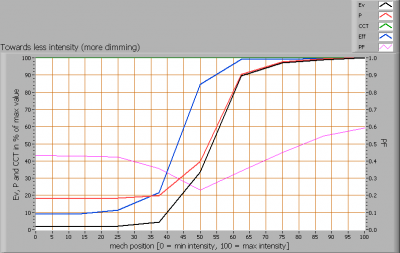
Dimming with the universal dimmer for low powers
The useful mechanical range is from 40 % to 80 %.
The illuminance can be set from almost 0 % to 100 %.
Inserting the dimmer (set at 100 %, meaning no dimming) gives no loss of illuminance.
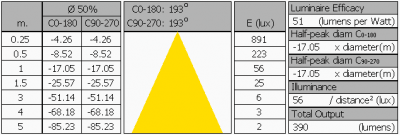
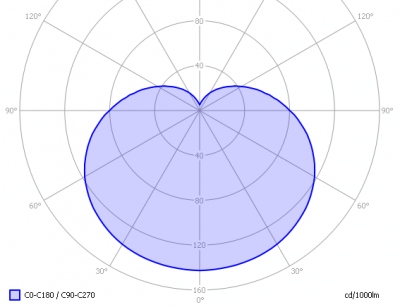
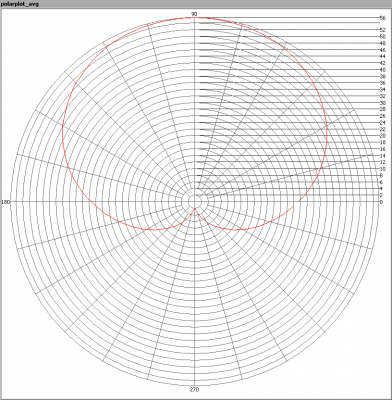
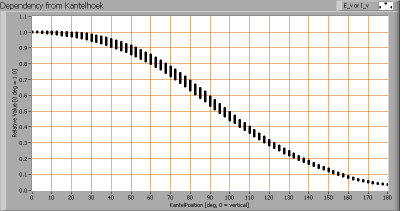
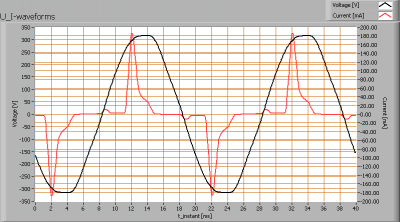
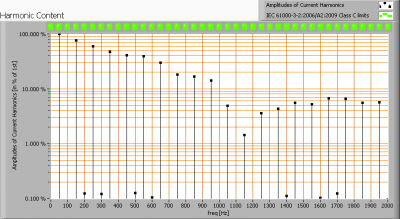
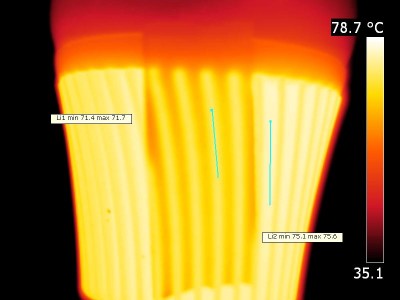
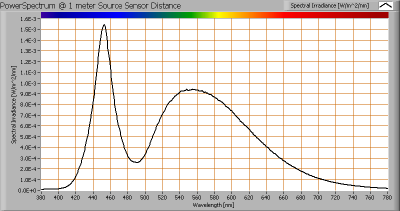
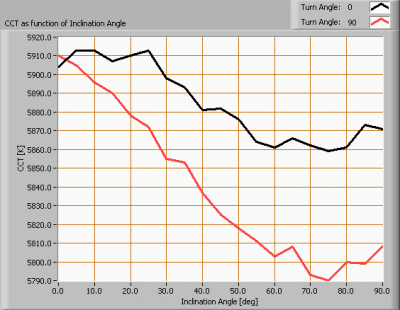
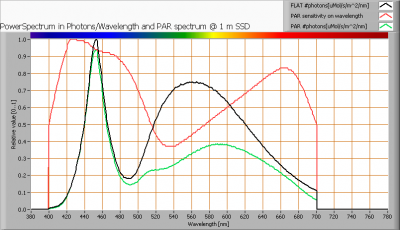
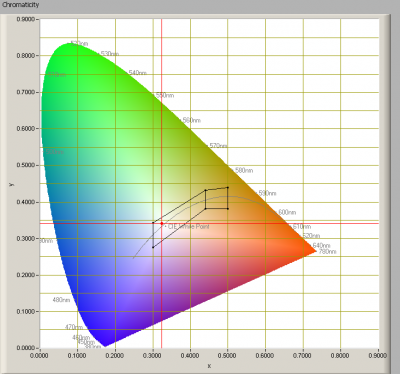
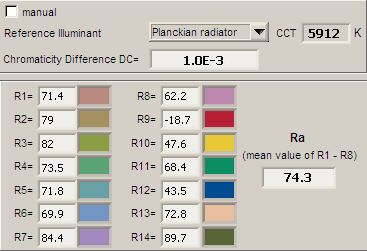
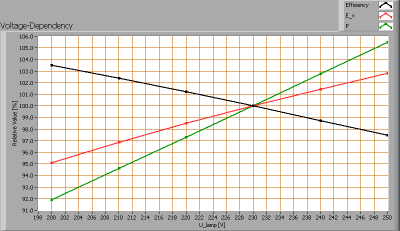
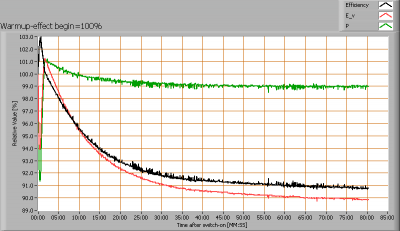
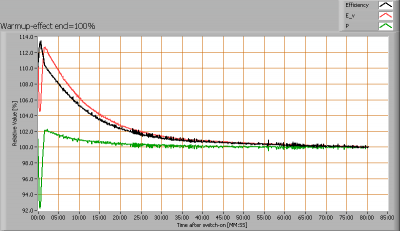
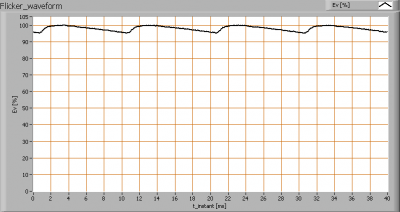
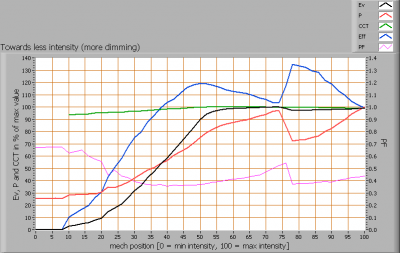
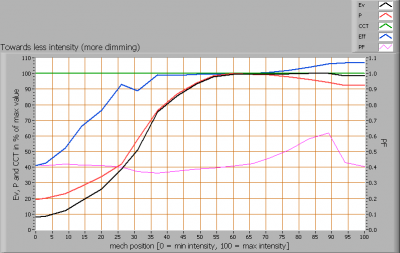



August 23rd, 2010 at 12:46 am
It looks like the LED Lamps are just getting better and better. I work with Sharp and have been doing some research on LEDs. I believe they are the lighting of the future due to their being eco-friendly, save energy, and are cost efficient. LED lamps